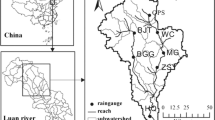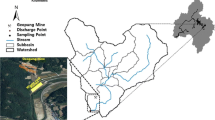Abstract
Purpose
Mercury (Hg) is a naturally occurring element and a pervasive toxic pollutant. This study investigated the dynamic loads of Hg from the Cedar–Ortega Rivers watershed into the Lower St. Johns River (LSJR), Florida, USA, using the better assessment science integrating point and nonpoint sources (BASINS)-hydrologic simulation program—FORTRAN (HSPF) model.
Materials and methods
The site-specific BASINS-HSPF model was developed for dynamic loads of Hg based on watershed, meteorological, and hydrological conditions. The model was calibrated and validated with existing field data. It was then applied to predict the daily and annual loads of Hg from the watershed outlet into the LSJR in response to rainfall events and water fluxes.
Results and discussion
In general, the predicted average daily total Hg flux during the 10-year simulation period was about 0.69 g ha−1 year−1. This finding was within the range of 0.22–1.41 g ha−1 year−1 reported in the Florida Everglades area. Simulations further revealed that the effects of rainfall events on Hg loading were significant, particularly in a very wet period. A maximum total Hg flux was predicted during this wet period at a rate of 122.59 g ha−1 year−1.
Conclusions
Results from this study provide a useful case study on estimating Hg contamination in watersheds. The approaches used in this study could be transferred to estimate the dynamic loads of Hg in watersheds from other regions.







Similar content being viewed by others
References
Babiarz CL, Andren AW (1995) Total concentrations of mercury in Wisconsin (USA) lakes and rivers. Water Air Soil Pollut 83:173–183
Balogh SJ, Meyer ML, Johnson DK (1998) Mercury and suspended sediment loadings in the lower Minnisota River. Environ Sci Technol 31:198–202
Bicknell BR, Imhoff JC, Kittle JL, Donigian AS, Johanson RC (1993) Hydrological Simulation Program—FORTRAN (HSPF): user’s manual for release 10. EPA-600/R-93/174. US EPA, Athens
Bicknell BR, Imhoff JC, Kittle JL Jr, Jobes TH, Donigian AS Jr (2001) Hydrological Simulation Program—Fortran, HSPF, version 12, user’s manual. National Exposure Research Laboratory, Office of Research and Development, U.S. Environmental Protection Agency, Athens, March 2001
Bishop KH, Lee YH (1997) In: Sigel A, Sigel H (eds) Metal ions in biological systems, vol 34. Mercury and its effects on environment and biology. Marcel Dekker, New York, p 113
Chen YD, Carsel RF, Mccutcheon SC, Nutter WL (1998) Stream temperature simulation of forested riparian areas: I. Watershed model development. J Environ Eng—ASCE 124:304–315
Clement International Corporation (1994) Toxicological profile for mercury. US Dept. of Health & Human Services, NTIS, Atlanta, p 366
Donigian AS Jr, Crawford NH (1976) Modeling pesticides and nutrients on agricultural lands. Environmental Research Laboratory, Athens, EPA 600/2-7-76-043, 317 p
Donogian AS, Imhoff JC, Bicknell BR, Kittle JI (1984) Application guide for hydrological simulation program-FORTRAN (HSPF). EPA, Athens. EPA-600/3-84-065
Driscoll CT, Yan C, Schofield CL, Munson R, Holsapple J (1994) The mercury cycle and fish in the Adirondack Lakes. Environ Sci Technol 28:137
Durell GS, Seavey JA, Higman J (2004) Sediment quality in the Lower St. Johns River and Cedar–Ortega River Basin: chemical contaminant characteristics. March 2001. Battelle, Duxbury, MA, 02332
Dvonch JT, Graney JR, Marsik FJ, Keeler GJ, Stevens TK (1998) An investigation of source-receptor relationships for mercury in south Florida using event precipitation data. Sci Total Environ 213:95–108
Eisler R (2004) Mercury hazards to living organisms. Taylor & Francis, Boca Raton, p 312
Fitzgeral WF, Gill GA (1979) Subnanogram determination of mercury by two-stage gold amalgamation and gas phase detection applied to atmospheric analysis. Anal Chem 51:1714
Fleck JA, Alpers CN, Marvin-DiPasquale M, Hothem RL, Wright SA, Ellett K, Beaulieu E, Agee JL, Kakouros E, Kieu LH, Eberl DD, Blum AE, May JT (2011) The effects of sediment and mercury mobilization in the South Yuba River and Humbug Creek Confluence Area, Nevada County, California: Concentrations, speciation, and environmental fate—Part 1: Field characterization. U.S. Geological Survey Open-File Report, 2010-1325A, 104 p
Freeman RJ (2001) Simulation of total suspended solids loads into the Cedar/Ortega River, Duval County, Florida Using SWMM. Department of Water Resources, St. Johns River Water Management District, Palatka, Florida. Technical Memorandum No. 46
Gill GA, Bruland KW (1990) Mercury speciation in surface freshwater systems in Califronia and toher areas. Environ Sci Technol 24:1392–1400
Glass GE, Sorenson JA, Schmidt KW, Rapp GR (1990) New source identification of mercury contamination in the Great Lakes. Environ Sci Technol 24:1059–1069
Guentzel JL, Landing WM, Gill GA, Pollman CD (2001) Processes influencing rainfall deposition of mercury in Florida. Environ Sci Technol 35:863–873
Hamasaki T, Nasamitsu H, Yoshitada Y, Sato T (1995) Formation, distribution, and ecotoxicity of methylmetals of Tin, mercury, and arsenic in the environment. Crit Rev Environ Sci Technol 25:45–91
Hultberg H, Munthe J, Iverfeldt A (1995) Cycling of methyl mercury and mercury—responses in the forest roof catchment to three years of decreased atmospheric deposition. Water Air Soil Pollut 80:1–4
Hurley JP, Shafer MM, Cowell SE, Overdier JT, Hughes PE, Armstrong DE (1995) Trace metal assessment of Lake Michigan tributaries using low-level techniques. Environ Sci Technol 30:2093–2098
Hurley JP, Cowell SE, Shafer MM, Hughes PE (1998) Tributary loading of mercury to Lake Michigan: importance of seasonal events and phase partitioning. Sci Total Environ 213:129–137
Keeler GJ, Marsik FJ, Al-Walli KI, Dvonch JT (2001) Modeled deposition of speciated mercury to the SFWMD Water Conservation Area 3A: 22 June 1995 to 21 June 1996. Project description and results. The University of Michigan Air Quality Laboratory, Ann Arbor
Krabbenhoft DP, Benoit JM, Babiarz CL, Hurley JP, Andren AW (1995) Mercury cycling in the Allequash Creek watershed, northern Wisconsin. Water Air Soil Pollut 80:1–4
Lange TR, Royals HE, Connor LL (1993) Influence of water chemistry on mercury concentration in largemouth bass from Florida lakes. T Am Fish Soc 122:74–84
Lathrop RC, Rasmussen PW, Knauer DR (1991) Mercury concentrations in walleyes from Wisconsin (USA) Lakes. Water Air Soil Pollut 56:295–307
Lee KE, Chon HT, Jung MC (2008) Contamination level and distribution patterns of Hg in soil, sediment, dust and sludge from various anthropogenic sources in Korea. Mineral Mag 72:445–7449
Morel FMM, Kraepiel AML, Amyot M (1998) The chemical cycle and bioaccumulation of mercury. Annu Rev Ecol Syst 29:543–566
Ouyang YJ, Higman J, Campbell D, Davis J (2003) Three-dimensional kriging analysis of sediment mercury distribution: a case study. J Am Water Resour As 39:689–702
Plouffe A (1995) Glacial dispersal of mercury from bedrock mineralization along Pinchi Fault, north central British Columbia. Water Air Soil Pollut 80:1–4
Rasmussen PE (1994) Current methods of estimating atmospheric mercury fluxes in remote areas. Environ Sci Technol 28:2233–2241
Rood BE, Gottgens JF, Delfino JJ, Earle CD, Crisman TL (1995) Mercury accumulation trends in Florida Everglades and Savannas Marsh flooded soils. Water Air Soil Pollut 80:1–4
Serpone N, BorgarelloE PE (1988) Photoreduction and photodegradation of inorganic pollutants: II. Selective reduction and recovery of Au, Pt, Pb, Rh, Hg, and Pb. In: Schiavello M (ed) Photocatalysis and environment. Kluwer Academic, Dordrecht, pp 527–565
Sim DB, Francis AW (2008) Mercury and cyanide used as indicators of sediment transport in ephemeral washes at the techatticup mine and mill site, nelson, Nevada (USA). Int J Soil Sediment Water 1:1–9
Stein ED, Cohen Y, Winer AM (1996) Environmental distribution and transformation of mercury compounds. Crit Rev Environ Sci Technol 26:1–43
Ullrich SM, Tanton TW, Abdrashitova SA (2001) Mercury in the aquatic environment: a review of factors affecting methylation. Crit Rev Environ Sci Technol 31:241–293
US EPA (2010) BASINS 4.0 ((Better Assessment Science Integrating point & Non-point Sources) Description. http://water.epa.gov/scitech/datait/models/basins/BASINS4_index.cfm. Accessed 16 September 2011
Author information
Authors and Affiliations
Corresponding author
Additional information
Responsible editor: Winfried Schröder
Rights and permissions
About this article
Cite this article
Ouyang, Y., Higman, J. & Hatten, J. Estimation of dynamic load of mercury in a river with BASINS-HSPF model. J Soils Sediments 12, 207–216 (2012). https://doi.org/10.1007/s11368-011-0426-4
Received:
Accepted:
Published:
Issue Date:
DOI: https://doi.org/10.1007/s11368-011-0426-4




